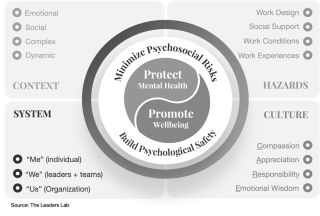Career
Stop and Check Your Workplace Well-Being Strategy
4 questions every workplace well-being strategy needs to address.
Posted April 12, 2023 Reviewed by Gary Drevitch
Every job involves some psychosocial (emotional and social) risks that have the potential to increase work-related stress, harm people’s mental and physical health, and, if prolonged, lead to burnout. A lack of role clarity, an unmanageable workload, inadequate reward and recognition, poor workplace relationships, and poor change management are just a few of the hazards people in your workplace are probably navigating right now.
But how is your workplace well-being strategy minimizing these risks?
As psychosocial injury claims have continued to grow, when it comes to protecting the mental health and well-being of employees and contractors, more than 70 countries have been part of updating international and national codes to clarify the responsibilities of workplaces. In Australia, these requirements have recently become legislation in several states with the risk of financial penalties for noncompliance.
So, what does this mean practically for your well-being approaches?
In our work with organizations around the world over the last six months we’ve noticed that workplace well-being strategies are often being pushed aside in favor of complying with new psychosocial hazard requirements. While we appreciate that the threat of financial penalties tends to grab leadership attention, unfortunately minimizing psychosocial risks will not achieve the same outcomes as promoting well-being.
As leading well-being expert Martin Seligman has noted, 50 years of psychological focus on fixing mental illness taught us little about caring for well-being. Unfortunately, because the codes and legislation have been designed through a risk management lens, they generally fail to clearly outline any workplace responsibilities for promoting well-being.
We’re not suggesting that workplaces should choose one approach over the other, but we are strongly advocating that efforts to protect mental health and promote well-being be strategically integrated. The alternative – which we are seeing in some organizations – of competing messages, policies, tools, and tasks for leaders and their teams risks creating confusion and stress, which cannot be what success looks like.

How can you integrate your psychosocial safety and well-being requirements?
We find this simple safety and well-being map (left) and the four questions below helpful in our conversations with workplaces:
1. How is your workplace well-being strategy supporting the complex and dynamic nature of psychosocial risks?
Psychosocial hazards arise from the ways we work together. They are the emotional and social challenges found in how we connect, communicate, and support each other as we organize the completion of our work. And while identifying the hazards, assessing them, controlling them, and reviewing our efforts sounds logical, the danger of “managing” psychosocial risks lies in underestimating the complex and dynamic nature of the ways we work together.
For better or worse, the ways we work together are rarely logical. This is because our diverse personalities, values, life experiences, skills, job demands, and hopes make our relationships at work complex. Add to this our dynamic, always-changing work environments, and even small changes such as an increased performance goal, a shortened deadline, or team changes can dramatically increase the psychosocial risks we experience.
This means doing everything “reasonably practicable” to eliminate or minimize psychosocial risks, as required by the legislation and codes, is never a “one-and-done” exercise but instead requires an ongoing commitment to learning how to safely navigate our complex relationships and dynamic workspaces together.
2. How is your workplace well-being strategy measuring and minimizing psychosocial risks?
The list of potential psychosocial hazards in most workplaces is long, and they tend to appear in groups rather than in isolation. Trying to stay on top of identifying these risks and “controlling” them, as the codes and legislation require, could easily become a full-time job in itself. While tailored actions to minimize or eliminate specific hazards across your workplace will be required, in practice your leaders need ways to integrate these new responsibilities and approaches into their existing ways of working.
3. How is your workplace well-being strategy building psychological safety at the “Me” (individuals), “We” (leaders and teams), and “Us” (organization) levels?
Our research has found that workers who report often feeling psychologically safe in their team are significantly less likely to be experiencing any psychosocial hazards. They were also significantly less likely to report feeling burned out.
Why might this be the case? Because psychological safety facilitates our capacity for candor, vulnerability, and learning together. It helps us feel more confident about requesting improvements to the way our work is organized, to call out a lack of social support when encountered, to address poor working conditions, and to ask for help with bad work experiences as they arise. Instead of biting our tongues in fear, we’re more likely to ask for help and seek shared accountability for effective solutions.
Our safety perceptions, experiences, and behaviors are diverse and distributed through a complicated web of social connections across our workplaces. At the “Me” level, the presence of personal portable psychological safety helps us to manage our fears and chase our hopes. At the “We” level, the shared beliefs that we are safe to speak up, take risks, and learn alongside each other makes it easier for us to collaborate, innovate, and grow. And at the “Us” level, a supportive organizational environment ensures that we have the resources we need to not just meet the demands of our jobs, but to excel.
4. How is your workplace well-being strategy helping your leaders to create a culture of CARE?
While safety is a business requirement, research has found that care is a business imperative that supercharges safety, well-being and performance. This is achieved by leaders often investing in expressions of compassion, appreciation, responsibility, and emotional wisdom (CARE) as teams go about our work. By embedding small actions of CARE into their existing role-modeling, routines, rituals, and rules, leaders can both minimize psychosocial risks and build psychological safety.
The right balance between protecting mental health by minimizing psychosocial risks and promoting well-being by building psychological safety will look different in each workplace. But the need to integrate both requirements into workplace well-being strategies is the same in every company. The only remaining question is, how soon will you begin?




